
Edward Winter

Yasser Seirawan (photograph courtesy of the Saint Louis Chess Club, Austin Fuller)
A miscellany of Chess Notes items concerning one of the world’s leading chessplayers, Yasser Seirawan.
A new magazine, Inside Chess, has been appearing fortnightly since the beginning of the year [1988]. Editor-in-Chief: Yasser Seirawan. General Editor: John Donaldson. In some respects it may be considered a cross between New in Chess and Players Chess News, with a style that is frank, direct and informal. Issue 11 (1 June 1988) has a fine report by Seirawan on the latest Grandmasters’ Association Board Meeting – more detailed and balanced than anything that seems to have been published elsewhere.
(1659)
From page 543 of the December 1982 BCM, in connection with a game of Seirawan’s against Karpov in the World Cup Chess television series:
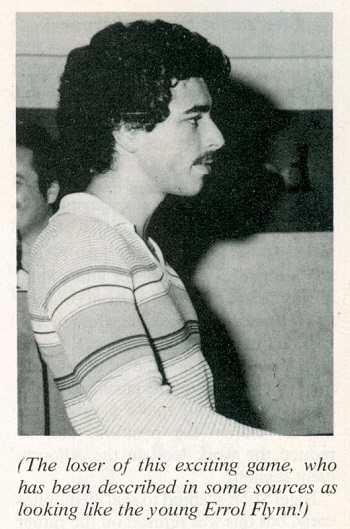
Below is part of C.N. 1971, dated 9 May 1993:
On 7 January 1993 Yasser Seirawan gave a telephone interview (lasting nearly three hours) to Hanon Russell for the USA Today Sports Centre. Seirawan’s comments on Fischer, with whom he spent about 15 hours during the 1992 Spassky match, are of particular interest. Some extracts follow, slightly edited by us ...
On Jews:
‘He explained to me that he was raised in a Jewish household, that he was basically abandoned by his father and that although he lived with his mother Regina, she went on to her education studies, left two children (his sister and him) at home, and he was very much abandoned as a child. I think that this terrible experience certainly affected him throughout his entire life. But he also explained to me that he was brought up in a chess community in Manhattan. He had to have a lot of savvy. There was an enormous number of Jewish people in the chess world, in New York, whom he communicated with on a constant day-to-day basis. Many helped him, and he acknowledges that. A little entry fee here, a book there, a ride there, etc. But he also says that many, many times he has had business affairs with Jewish businessmen which have not worked out. As a result of these experiences, his answer is “I don’t want to deal with Jews any more. That’s just the way it is. Yasser, I’m sorry, it’s a closed question”.’
When Seirawan argued that Fischer was ‘condemning a whole group of people’, Fischer replied: ‘Yasser, I know you think I’m being unfair. It’s just my experience. My reasons.’ Seirawan commented to the interviewer that Fischer ‘is a racist, he is not a Nazist’ and that he ‘magnifies his problems out of proportion. He takes his problems and puts them on the world stage’.
For the full text of C.N. 1971, see pages 211-212 of Kings, Commoners and Knaves and Instant Fischer. Attention is also drawn to our feature articles Brad Darrach and the Dark Side of Bobby Fischer and Chess and Jews.
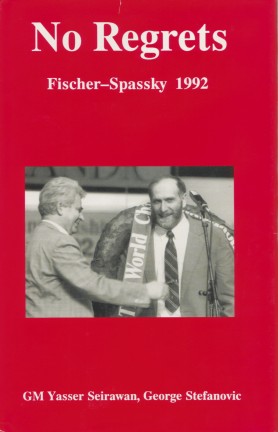
Yasser Seirawan informs us that the book Bobby Fischer Teaches Chess (first published in 1966) has now sold over a million copies. The source of this information is the latest royalty statement received by a co-author, Stuart Margulies.
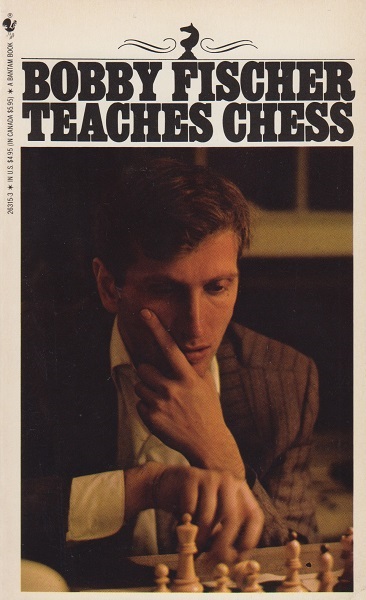
We have occasionally touched on the topic of chess book sales, but it would seem impossible to list authoritatively the best-selling titles, past or present. Is Fischer the only world champion to have a book sell a million copies?
(2267)
See Chess Book Sales.
On the subject of best games, as noted on page 148 of A Chess Omnibus there is no consensus among today’s masters about the Morphy v Duke and Count game. In C.N. 2287 Yasser Seirawan informed us:
‘Regarding the best game of chess ever played, certainly none of my own games spring to mind. Morphy v the Duke and Count is arguably the most quoted game of all time and has much that is special about it. It is fair to say that no other game has brought so much pleasure to so many. The best game of chess ever played? Can there be such a thing? Would a perfect game not be boring? Can a mere off-hand game be the best ever? I don’t know the answers and, in spite of the questions, Morphy v the Duke and Count gets my vote.’
Naming racehorses after chess masters (see page 5 of the 6/2000 New in Chess) is not a novelty, and there was already a four-legged Steinitz in the nineteenth century. The Spirit of the Times of 24 April 1886 reported that T. Frère had given that name to his bay colt, and this prompted Steinitz to declare on page 113 of the May 1886 International Chess Magazine:
‘I can only express my most thankful appreciation of the unique and original compliment paid to me by Mr Frère, and I wish the utmost success to my namesake on the Turf.’
On page 331 of Chess Review, November 1952 Tartakower wrote:
‘It is well known that Capablanca was very popular in Buenos Aires; and, after I visited that city in 1931, my name often appeared in the newspapers there. Later on, we each had a racehorse named after us. It was gratifying to learn that “Tartakower” (the racehorse) chalked up more victories than his equine rival, “Capablanca”.’
(2437)
From Yasser Seirawan:
‘In 1999 I chaperoned the Malaysian businessman Dato Tan Chin Nam on his visit to Seattle. He asked my permission to have a racehorse named after me, and I happily assented, asking if he had others named after leading chessplayers. Dato stated that his stable included a racehorse called Kasparov. “In that case”, I said, “just make sure my horse is faster than Kasparov”.’
(2466)
Yasser Seirawan’s Foreword to Kings, Commoners and Knaves.
In 2000 Yasser Seirawan published on his Inside Chess website a strongly-worded open letter ‘Enough is Enough’ which called on the FIDE President to resign. In a follow-up article (also on-line at Inside Chess) Seirawan reviewed the reaction, including that of the ‘long time rabid critic of FIDE, GM Evans’. After pointing out how Evans had misrepresented his open letter, Seirawan concluded: ‘Experienced Evans-watchers know that it is the kind of untruth and distortion that is endemic in him.’
Source: The Facts about Larry Evans.
From pages 12-13 of the Autumn 2009 Kingpin, in an article entitled ‘Machiavelli on Ice’ (pages 10-22):
Yasser Seirawan’s editorial of 17 April 2000 [on the Inside Chess website] began:
‘On the eve of the press conference [for the Kasparov-Kramnik match – Ed.], Keene’s business partner and former brother-in-law IM David Levy charged Keene with embezzling funds from their company to fund a separate lucrative venture for himself! I’m shocked, shocked! Keene has since denied the charges, claiming that he had actually loaned money to the company and had not embezzled nary a shilling. Hardly an auspicious beginning for Braindrains, sorry Braingames. The question we will be forced to ask is, will this new initiative last longer than the WCC?
As for David Levy and his blinding epiphany, where on earth was Levy when Korchnoi showed that Keene had broken his contract when working as his second at the 1978 world championship match? Where was Levy when Edward Winter presented irrefutable evidence of Keene’s misconduct on a whole variety of issues? Where on earth was Levy when GM Tony Miles told the world that he and Keene had jointly conspired and did in fact defraud the British Chess Federation? Wasn’t it this charge that brought a swift resignation and graceless exit from the BCF by Keene? Where was Levy when Keene was caught red-handed plagiarizing copyrighted material from Inside Chess magazine for one of his potboilers? It seems that Levy has only recently seen the light.’
Levy’s response to Seirawan’s admonishment of him was the simple confession – ‘Fair enough, Yasser’.
See also David Levy on the Brain Games Scandal, 2000-2003.
Concerning the Alekhine v Najdorf mystery, Yasser Seirawan writes to us:
‘During the Americas v Europe match-tournament in Mar del Plata in 1981, as well as at subsequent meetings, Najdorf told me a similar story to the one in C.N. 3367, but with some different details. The Polish club, he claimed, deliberately annoyed Alekhine by announcing that only 20 players had paid for the privilege to participate, and Alekhine insisted on being paid the agreed fee despite having only half the field. Reluctantly, the club directors agreed and proposed that Alekhine play ten games by sight and ten blindfold. Alekhine agreed. The club then snuck all the best players into the blindfold room and put ten patzers on the games that Alekhine could view. Just as the club directors had contrived, Alekhine had a terrible time. He wiped out the players he could see and sat racking his brains on the blindfold games, where the masters were in ambush.
Concerning his own game, Najdorf told me he was on the black side of a Sicilian in which the players had castled on opposite wings. Alekhine was breaking through when Najdorf uncorked the standard …Rc8xc3 exchange sacrifice. Alekhine had seen that shot and did not bother to recapture the rook, pursuing his own attack instead. The move he had missed was the follow-up …Rc3xa3, and Najdorf’s attack was first and decisive.
Najdorf added that many years later he had hosted Alekhine in a drinking bout in Buenos Aires. They both got thoroughly drunk. In a toast Najdorf declared Alekhine the greatest chessplayer ever but added, “Just remember: our score is one draw and one win in my favor”. Alekhine maintained that even if drunk he knew that their score was one draw. Najdorf then reminded Alekhine of the Polish display, and Alekhine said, “Are you the one who gave me …Rxa3?” Najdorf was astounded at Alekhine’s memory, even when he was intoxicated.
Najdorf was a great storyteller but certainly prone to exaggerate. I would be interested in knowing whether this particular tale is myth or fact.’
(3369)
What is the shortest possible game (real or invented) in which a player’s queen is trapped in the middle of the board? The briefest specimen we have seen is in an Assiac book, but readers are left for now to reflect upon the matter.
(3579)
The game we had in mind was 1 e4 e6 2 d4 Qf6 3 e5 Qf5 4 Bd3, which was given on page 9 of The Pleasures of Chess by Assiac (New York, 1952). It may, however, be argued whether, on f5, the queen is in the ‘middle of the board’. If only d4, d5, e4 and e5 are admitted, no four-move solution has been found, although there are various ways in five moves, such as 1 e4 e6 2 d4 d5 3 Qh5 Nf6 4 Qg5 h6 5 Qe5 Bd6 and 1 e4 c5 2 Qh5 d6 3 Qd5 e5 4 Bd3 Nc6 5 Nc3 Be6. Indeed, Black can even include a ‘null’ move, examples being 1 e4 a6 2 Qh5 Ra7 (or other) 3 Qe5 e6 4 f4 f5 5 c3 Nc6 and 1 e4 e6 2 d4 Ke7 (or other) 3 Qh5 d5 4 Qe5 f5 5 f4 Nc6. Not surprisingly, therefore, a solution has been found which takes half a move less: 1 Na3 e5 2 Nc4 Qh4 3 d3 Qd4 4 f4 d5 5 Be3. Our thanks to a number of correspondents who have contributed to this topic, and particularly Yasser Seirawan and Richard Forster.
(3589)
It is not only the old-timers’ quotes which may prove difficult to trace. Page 56 of Modern Chess Analysis by R. Smith (London, 2004) attributes to Seirawan the observation ‘Let the perfectionist play postal’. It is, indeed, a commonly-seen quote, but Yasser Seirawan informs us:
‘At the moment I simply cannot place this remark.’
(3870)
The following comment by Yasser Seirawan at ChessBase in October 2006 is to be noted:
‘Campomanes, as we know, aborted the 1984/85 World Championship match. I make no judgment as to the rights and wrongs of that exceptionally complicated case; after all, it threw up so much contradictory evidence that the only fair-minded conclusion is agnosticism on whether or not Campomanes was correct to terminate the match.’
See The Termination.
In C.N. 4121 Calle Erlandsson (Lund, Sweden) contributed four photographs of the Euwe memorial which were taken by him on 27 November 2004:
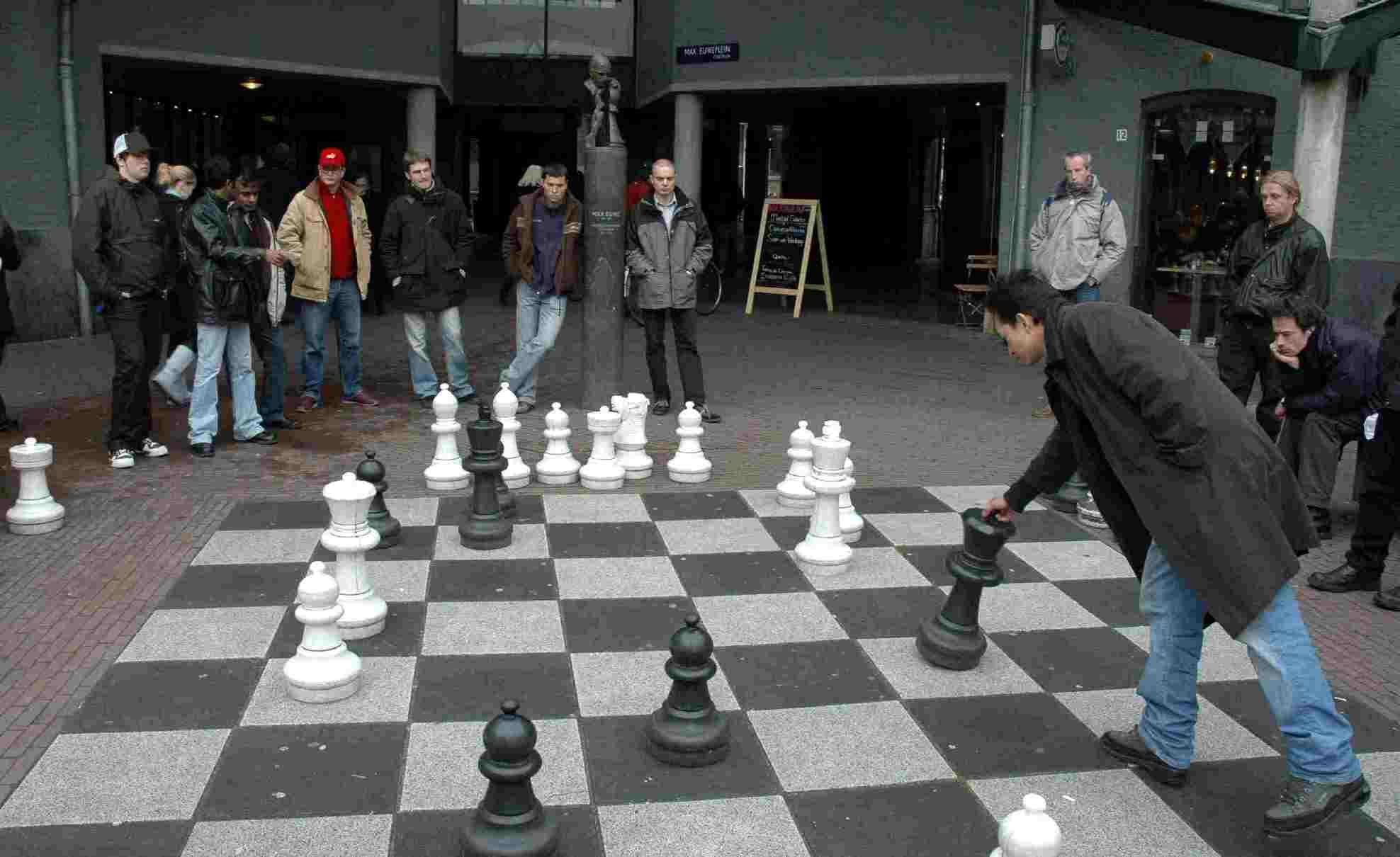
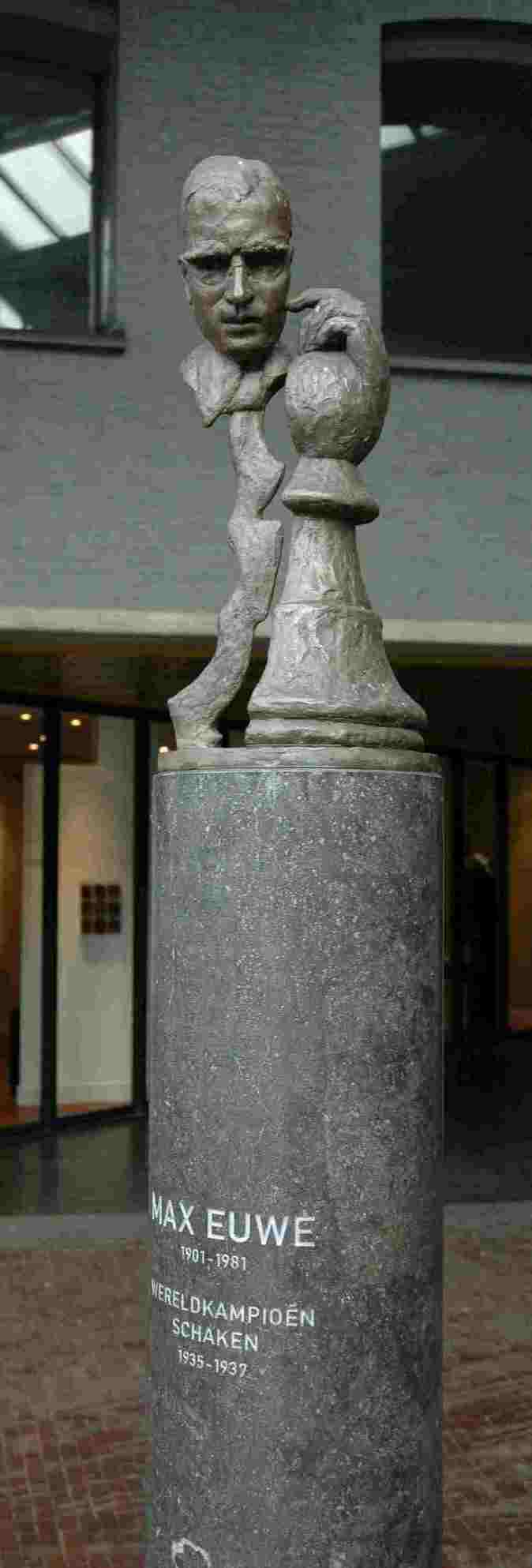
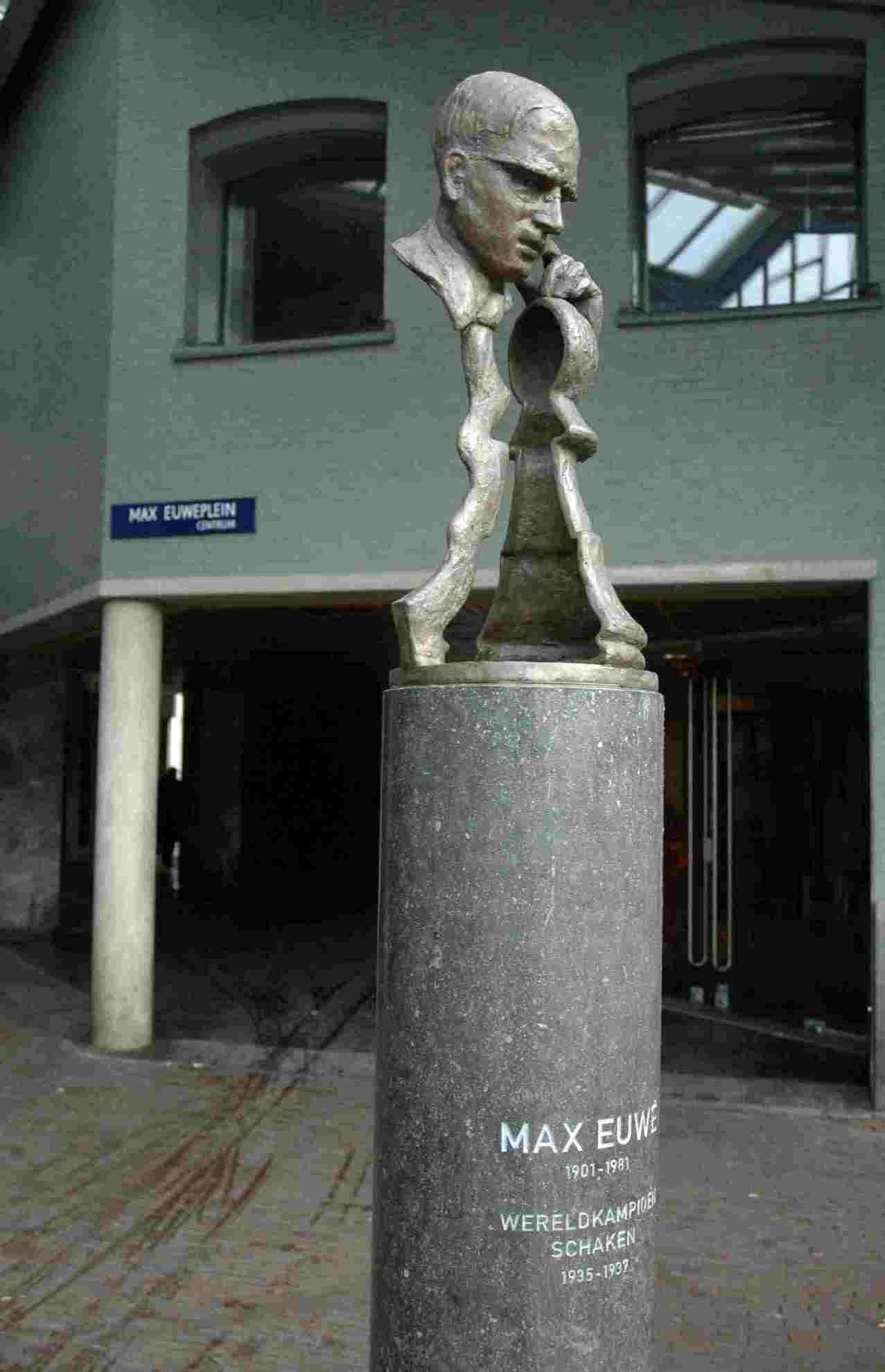
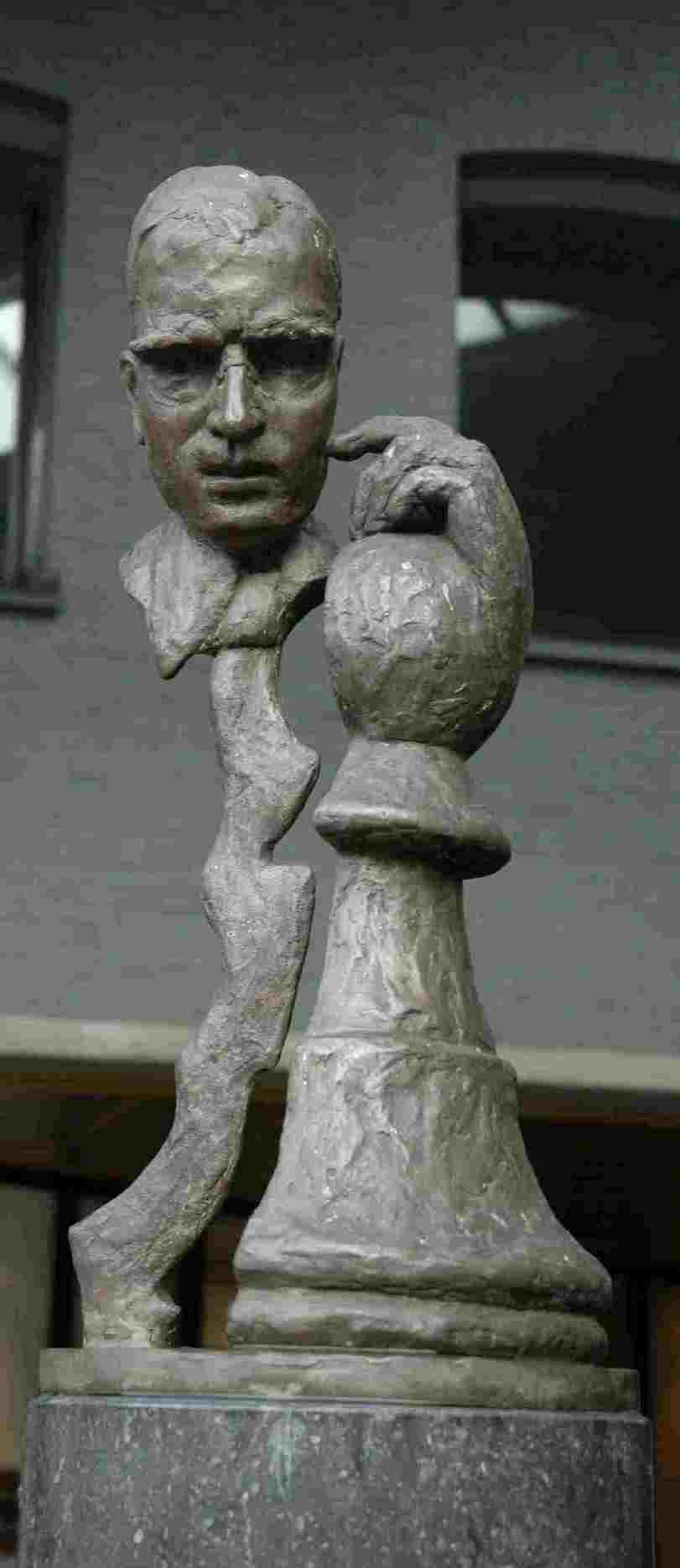
There exists a miniature version (approximately 20 centimetres in height), and we are grateful to Yasser Seirawan for a photograph of the copy which he possesses:
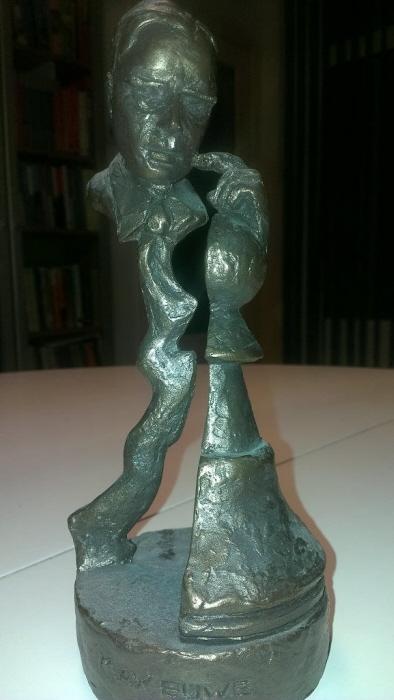
See also Chess Statues and Sculpture.
An extract from Reflections on Garry Kasparov, written by us in 2005:
After enjoying a decade and a half of pugnacious pre-eminence, Kasparov lost a matchlet to Kramnik in Hammersmith, London in 2000 through atypically listless play, after which his supporters, and then others, took to describing him not as ‘the former world champion’ but, on account of his rating, as ‘the world’s number one player’. It was an Elo-inspired variation of the description of Capablanca on the title page of the US edition of his 1935 book A Primer of Chess: ‘World’s foremost chess expert’.
In the late 1990s FIDE was favouring rapid play, knock-out tournaments, mini-champions and, more generally, whatever flew in the face of chess tradition. In the meantime, the top masters were left to their own devices. At first they indulged in tractations about a new world championship cycle, with each potential contender seeing any anticipated personal benefit as a birthright and any putative personal disadvantage as an affront. But was it all really necessary? If a direct re-match had been organized between Kramnik and Kasparov, without any qualification system, the other leading lights would, of course, have complained long and hard, yet Kasparov’s status was incomparable and anno Domini was becoming a factor.
Qualifying matches were projected, announced and abandoned, but in May 2002, 18 months after the Hammersmith débâcle, the seemingly impossible was achieved in Prague with the thrashing-out and signing of a Resolution ‘on the Unification of the Chess World’. Although a compromise which fell short of Yasser Seirawan’s original proposal, it became the only realistic prospect of bringing about a match for the undisputed world championship.
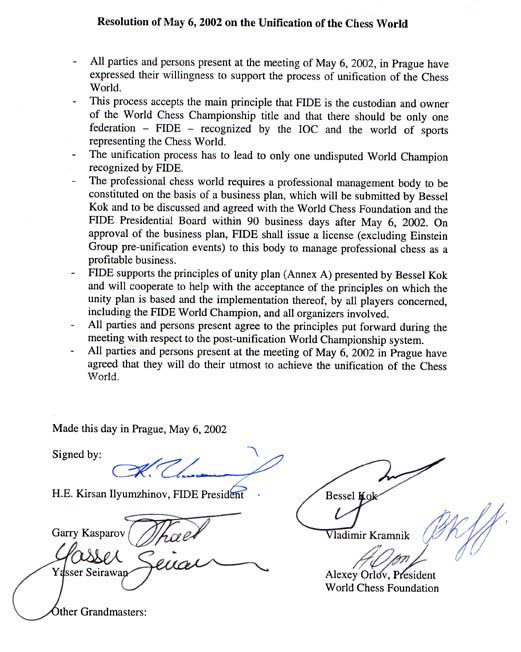
Throughout that process, steered by Seirawan, Kasparov conducted himself better than most and better than usual. All the signatories undertook to ‘do their utmost to achieve the unification of the Chess World’, but ‘utmost’ is an undefinable word. More qualifying matches were projected, announced and abandoned, and when the Resolution eventually wilted away into limbo Kasparov was the most aggrieved party. Some of his detractors no doubt viewed this as his come-uppance, and it could indeed be regarded as the culmination of events which he himself had set in train during the nadir of his chess career, i.e. the break-away from FIDE in 1993. That episode, which has caused world championship bedlam for a dozen years, was seen as an obvious calamity by any level-headed observer at the time. To Kasparov, however, the reality did not sink in until much later: on page 13 of the 2/1999 New in Chess he described the founding of the PCA in 1993 as his biggest mistake of all.
Yasser Seirawan asks:
‘What hard facts are available regarding the chessplaying strength of Marshal Tito of Yugoslavia?’
We throw the question open to readers and offer, in the meantime, two photographs:
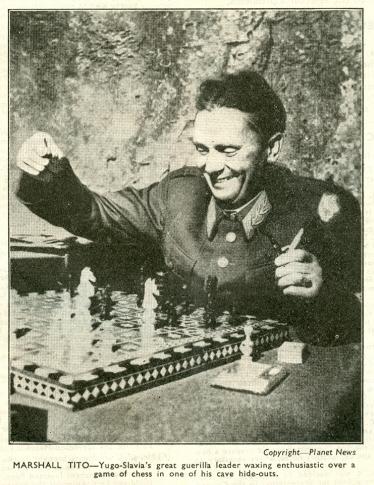
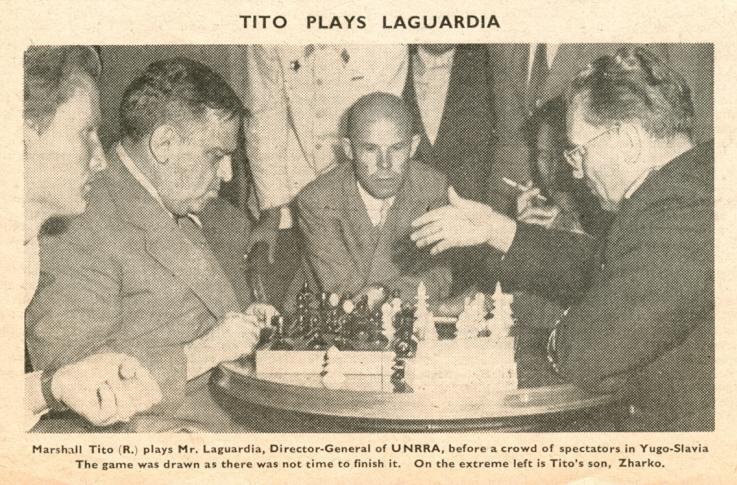
The pictures appeared in CHESS, in November 1944, page 17, and September 1946, page 285 respectively. The first photograph was included in a set of four on page 233 of Persönlichkeiten und das Schachspiel by B. Rüegsegger (Huttwil, 2000).
(5293)
For follow-up information and pictures, see C.N.s 8012 and 8140.
From Yasser Seirawan:
‘I am currently writing a romance/adventure novel which features a chess theme. It was originally written in 1980 and 1981, but a baggage mishap during a flight to Berlin caused me to lose my only (handwritten) copy. Laptops did not exist in those days. Now, half a lifetime later, I have revived the project. How many grandmasters have written a novel?’
Two works come to mind: Belye i chernye by A. Kotov (Moscow, 1965) and Los Voraces 2019 by A. Soltis (Jefferson, 2004). Regarding the former, which concerned Alekhine’s life, see C.N. 4073 for information about the ensuing film. The dust-jacket of the Czech translation of the novel (Prague, 1971) is reproduced below:
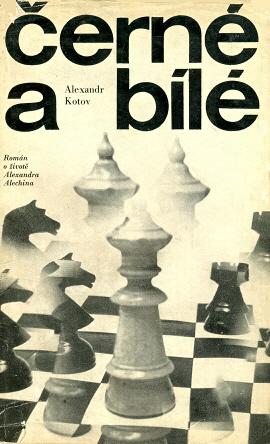
(5366)
Jon D’Souza-Eva (Oxford, England) asks which configurations Capablanca advocated for a different form of chess. We give below three quotes from the Cuban’s writings which appeared in our book on him:
‘To make only the changes that are necessary, I have suggested that instead of 64 squares there should be 100, i.e. a 10x10 board instead of 8x8. There would thus be two extra pawns and two more major pieces behind them. To complete the range of moves, one of the pieces would have the combined moves of the bishop and knight, and the other those of the rook and knight. One would be placed on the queen’s side, the other on the king’s side. Instead of having the option of moving one or two steps, pawns would be able to move one, two or three.
The remaining rules would stay the same.’
Source: Article on Moscow, 1925 in Revista Bimestre Cubana, Volume XXI, Number 2, March-April 1926.
‘Personally, I am in favor of the 100-square board, 10 by 10, with two new pieces for each side, the one to have the powers of the rook and knight, and the other the powers of the bishop and knight. Where exactly these pieces should stand at the start can be settled later, though I suggest one each next to the king and queen; and there would be another minor change to consider, in giving permission for the pawns to move one, two or three squares on the first move, in order to bring the opposing sides more quickly in touch with one another. The broad principle is the 100-square board, which I prefer to the 80-square board, 10 by 8, and the new pieces.’
Source: Letter to The Times (London), 24 November 1928, page 13.
‘My own suggestions involve the introduction of new pieces upon the board: the Chancellor, combining the moves of the bishop and knight; and the Marshall [sic], combining the moves of the rook and the knight. This means to say that the Chancellor may be used either as a bishop or as a knight for any move according to the will of the player, while the Marshall in the same way can be used as a rook or knight. The latter piece, I think, would prove the stronger in an endgame. The introduction of these two pieces would of course mean a 100-squares board and two extra pieces on each side. But it would not entail any alteration of the rules.’
Source: Interview/article entitled ‘Brighter Chess’ on pages 44-45 of the Chess Amateur, November 1929.
Our monograph also quoted Edward Lasker on pages 427-428 of Chess Secrets I Learned from the Masters (New York, 1951) and on page 263 of the April 1974 Chess Life & Review. He indicated that in later years Capablanca came to prefer a 10x8 board, but we recall no writings to that effect by the Cuban or, indeed, anything published by him on ‘changing the rules’ after the 1920s.
There is an excellent entry for Capablanca Chess on pages 38-40 of The Encyclopedia of Chess Variants by David Pritchard (Godalming, 1994).
(5618)
From Yasser Seirawan:
‘I love the powers of the two new pieces introduced by Capablanca but strongly dislike the names that he assigned to them: Chancellor and Marshall/Marshal. What imagery comes to mind with those names, and how could such images be converted into pieces for the chess board? What would they look like? Nor do I like the 10x10, or even the 10x8, board.
That is why Bruce Harper and I created a new chess variant. We renamed the Marshall/Marshal an Elephant (having the powers of the rook and knight) and the Chancellor a Hawk (with the powers of the bishop and knight).
The “novelty” lies in the way these new pieces are introduced into play, on an 8x8 chess board. At the start of the game they are out of play, and they do not appear on the board until there is a vacant square on the player’s back rank. Thus each player has a maximum of eight opportunities to bring in the two new pieces. They may be introduced on any move when one of the original pieces moves from the back rank. For instance, the opening move 1 Nf3 vacates the g1 square, and White would have three options: a) 1 Nf3, b) 1 Nf3/Hg1, and c) 1 Nf3/Eg1.
A practical example: 1 d4 d6 2 e4 e5 3 dxe5 dxe5 4 Qxd8/Ed1 mate.’
For more details, see the webpage Seirawan Chess.
(5622)
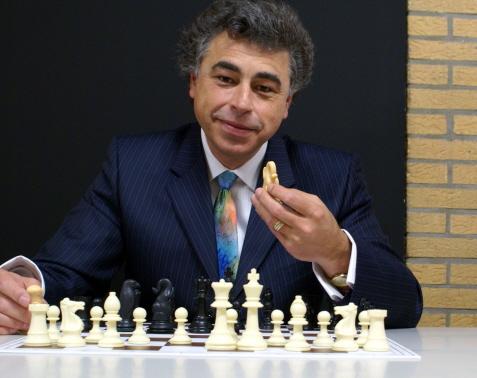
Yasser Seirawan writes:
‘Both Bruce Harper and I take pride in “adapting” Capablanca’s pieces to the 8 x 8 board with the creation of “S-Chess”, as opposed to Capa’s suggestion for a 10 x 10 board. Is it possible that others before us also tried to “improve” on Capa’s variant? Did any of the proposals try to make Capa’s new pieces “fit” on an 8 x 8 board?’
(11965)
Readers are also referred to our Chess Variants and Rule Changes feature article.
Regarding the annotational disagreement between Staunton and Saint-Amant arising from the 16th game of their match in Paris in 1843 [see C.N. 5709], the first diagram below shows the position after 19...Na7-b5. Play continued 20 exf5 gxf5 21 Nh5 Qe8 22 Nxf6+ Rxf6 23 fxe5 Qxe5, reaching the second diagram.
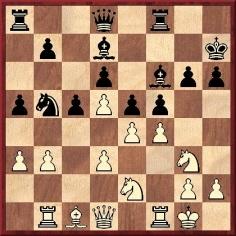
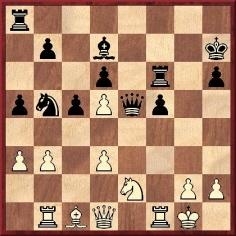
Yasser Seirawan writes:
‘After 19...Nb5 I much prefer Black’s position. I consider Staunton’s move 20 exf5 to be dubious because, as Saint-Amant correctly points out, the d5-pawn becomes weak. After 21 Nh5 I would have played 21...Bh8, retaining the two bishops and raising the question of what the white knight is actually doing on h5.
Regarding the second position, I am not sure that Black stands better any more, and he may have frittered away his advantage at this point by failing to keep his two bishops. So is Saint-Amant’s claim that Black has the attack true? After 24 Bb2 Nd4 (if 24...Qe3+ 25 Kh1 Rf7 26 Rf3 and 27 Nf4, I do not see Black’s “attack” at all) 25 Bxd4 cxd4 26 Nf4, and White’s problems are over.’
(5715)
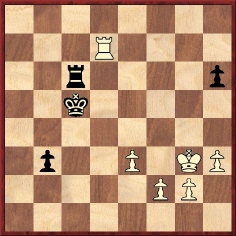
Regarding this position from Capablanca v Thomas, Carlsbad, 1929, Yasser Seirawan remarked in C.N. 4730:
‘A quick impression is that Black should win by direct means after 47 Rd7: 47...b2 48 Rd1 Kb4 49 Rb1 Kb3! 50 f4 Rc1! 51 Rxb2+ Kxb2 52 Kh4 (With the rook now on the first rank the advance 52 f5 is a mistake as 52...Rf1 53 e4 Kc3 makes the task easy.) 52...Rc6! (Covering the h6-pawn, cutting off the white king and preparing to bring the black king into play.) 53 g4 Kc3 54 Kh5 Kd3 55 g5 hxg5 56 fxg5 Ke4, and Black is in time to stop the pawns for a win.
This is by no means an exhaustive analysis, but just a check of the direct line. It is possible that 50 f4 is wrong, but I based my analysis on that move as it seemed to be the main line of others.’
Dennis Monokroussos (South Bend, IN, USA) has now written to us:
‘Regarding the interesting and surprisingly complex Capablanca-Thomas endgame, Yasser Seirawan addresses 52 Kh4 and 52 f5, correctly noting that both moves lose. White has a third possibility, however: 52 Kg4. This prepares to shoulder off the Black king and should be good enough for a draw. For example: 52...Rc6 53 f5 Kc3 54 Kf4 Kd3 55 Ke5 Kxe3 56 f6, with a drawn position. One possibility is 56...Kf2 57 f7 Rc8 58 g4 Kg3 59 Kf6 Kxh3 60 g5 hxg5 61 Kxg5, followed by Kg6-Kg7-f8(Q).’
Yasser Seirawan comments:
‘The idea proposed by Mr Monokroussos is a very good one. His plan of shouldering away Black’s king in the line he gave after 52...Rc6 was certainly missed by me. I likely entertained 52 Kh4 as the main move in order to prepare g2-g4 in one go, so to speak. The move 52 Kg4 invites Black to play 52...Rg1, putting the rook behind White’s g-pawn with the gain of a tempo, which is why I rejected the move. However, White can draw by jettisoning the g-pawn with 52...Rg1 53 Kh5 Rxg2 54 Kxh6 Kc3 55 f5 Rf2 56 Kg6 Kc4 57 h4 Kd5 58 h5, when Black has various tries, but White is fast enough. For example: 58...Kd6 59 h6 Ke7 60 h7 Rg2+ 61 Kh5 Kf7 62 h8(N)+ Kf6 63 Ng6, and the knight escapes thanks to the help of White’s pawns.’
(5820)
Yasser Seirawan asks, following on from C.N. 5932, which future world champions played previous title-holders in simultaneous displays.
Readers’ help in drawing up full details will be welcome. A familiar case is Botvinnik’s defeat of Capablanca in Leningrad in November 1925. As mentioned on page 105 of our book on Capablanca, it has also been claimed that in 1920, when not yet world champion, the Cuban drew with Euwe. See page 95 of volume two of Around The Chess World in 80 Years by N.J. Divinsky (St Leonards on Sea, 1965).
(5944)
As regards games played by future world champions against previous title-holders in simultaneous displays, our list now stands as follows:
Acknowledgements: Javier Asturiano Molina (Murcia, Spain), Eduardo Bauzá Mercére (New York, NY, USA) and Hassan Roger Sadeghi (Lausanne, Switzerland).
(5953)
Addition on 27 August 2022:
From Joose Norri (Helsinki):
‘In the GMs/Young Pioneers match in Leningrad in 1975, Kasparov played both Karpov and Smyslov. Kasparov mentions the games on page 81 of volume five of his Predecessors series.’
As is well known, Yasser Seirawan was born in Damascus, of a Syrian father and a British mother. However, on page 53 of his book Docklands Encounter (London, 1984) Raymond Keene claimed that Seirawan was ...
‘... born in England of mixed US and Syrian parentage’.
Page 278 of Warriors of the Mind (Brighton, 1989), a book co-bungled with Nathan Divinsky, re-affirmed that Seirawan was ...
‘... born in England of mixed US and Syrian parentage’.
When Warriors of the Mind was re-issued in 2002, the errors were, of course, left untouched.
Four years later, Messrs Keene and Divinsky, together with Jeff Sonas, produced a book entitled Who was the Strongest? Warriors of the Mind II. Page 270 stated that Seirawan was ...
‘... born in England of mixed US and Syrian parents’.
(6292)
C.N. 12048 referred to Raymond Keene, OBE, Ctrl+C, Ctrl+V.
C.N. 1666 (an item reproduced on page 4 of Kings, Commoners and Knaves) gave the game W.J. Wolthuis v C.H.O’D. Alexander, Maastricht, 1946, which featured a position used in an episode of the television series Columbo, starring Peter Falk. See also C.N. 3986.
Readers’ help in obtaining some biographical information about Wolthuis will be appreciated. There was more than one player with that surname, and the photograph below (from the Groningen, 1946 tournament book by Euwe and Kmoch) shows H.J. Wolthuis:
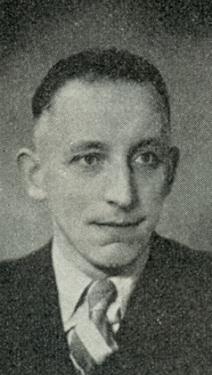
A picture of Peter Falk with Yasser Seirawan (as well as Larry Christiansen) appeared on the front cover of the December 1983 Chess Life:
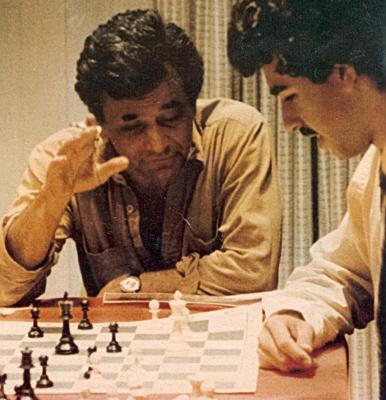
The cover also had a smaller photograph of Falk in conversation with Korchnoi. See Chess and Television.
(6347)
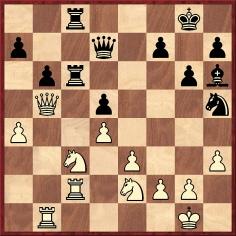
In this position (Reshevsky v Myagmarsuren, Sousse, 1967) White played 28 Rbc1. David Abrams (Syracuse, NY, USA) writes that although that move was the subject of no remarks on page 132 of Winning Chess Strategies by Y. Seirawan with J. Silman (Redmond, 1994 and London, 2003), 28 Nxd5 is much stronger.
We add that the game was annotated on pages 14-15 of Chess Review, January 1968 by Hans Kmoch, who commented as follows on Black’s previous move (27...Rec8):
‘Black is speculating on 28 Nxd5? a6!’
However, Yasser Seirawan informs us:
‘I too was seduced by the idea that the retort 28...a6 would refute the capture of the pawn at d5. That is not the case, as the continuation 29 Rxc6 axb5 30 Rxc8+ Kg7 31 Nxb6 (the move I had missed) and 32 Rxb5 is a clean win for White.’
(6599)
Yasser Seirawan asks who introduced the term ‘Berlin Wall’ in connection with 3...Nf6 in the Ruy López.
Readers are invited to cite earlier occurrences than our own spontaneous suggestion: an article entitled ‘Breaking down the Berlin Wall’ by Jimmy Adams on pages 337-346 of the August 1979 BCM.
(6808)
From Steve Giddins (Rochester, England):
‘The Jimmy Adams article to which you refer deals with the line 4 O-O Nxe4 5 Re1, which is a general way to meet the Berlin Defence. In this context, Adams’ use of the term “Berlin Wall” was simply a pun on his part, based on the general reputation for defensive solidity that the Berlin Defence has always enjoyed. However, the term “Berlin Wall” has become more widely used in recent times, to refer specifically to the endgame arising after the sequence 4 O-O Nxe4 5 d4 Nd6 6 Bxc6 dxc6 7 dxe5 Nf5 8 Qxd8+ Kxd8. It is thus a way of distinguishing this nowadays popular variation of the Berlin Defence from other lines, such as the Rio de Janeiro variation, beginning 5...Be7.’
(6812)
See The Berlin Defence (Ruy López).
From Yasser Seirawan, regarding Ståhlberg v Capablanca, Margate, 1936 (discussed in C.N.s 8169 and 8184)
‘An amusing comedy of errors, to be sure. It seems quite dangerous to agree to a draw and then play on to a specified number of moves before stopping.
Certainly, 26 Rxa6 was a bad error, and with 26...Nc5 Capablanca could have turned the tables decisively.
The immediate 26 Rd6 would still allow White to keep some advantage.
The favor was returned immediately by 26...Rab8, a bad move because 26...Nc5 is so much better.
Instead of 27...Qb7 (?!), either 27...Qc5 or 27...Qa5 would be better. The disadvantage of 27...Qb7 is that the queen does not protect the d8 rook, which makes the pin on the d-file hard to disentangle.
After falling into a terrifying pin on the d-file Black would seem lost. Although the suggestion 30 Bxe5 is a fine one, I think that 30 Rxe5 is far stronger, as Black is then tied and tethered. The critical continuation seems to be 30...Qxb2 31 Re1, when the solution to Black’s problem of the d-file pin remains a mystery to me.’
(8189)
Ryan Paulis (Amsterdam) notes the high prices being charged on the Internet for No Regrets by Y. Seirawan and G. Stefanovic (Seattle, 1992). On abebooks.com a vendor in Merchantville, NJ, USA is asking $1,250 for the hardback edition in ‘very fine’ condition.
The original price of the book, published in December 1992, was $34.95 (or $24.95 for the softback edition).
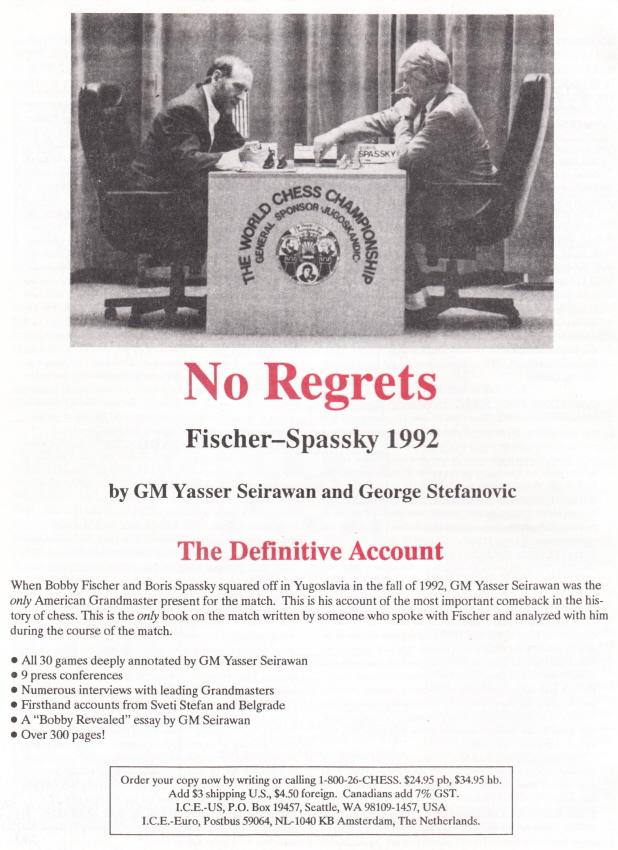
Back cover of the 25 January 1993 issue of Inside Chess
No Regrets, by far the best book on the 1992 Fischer v Spassky match, is indeed hard to come by nowadays, but there is little logic in chess book prices on the Internet. C.N.s 2308 and 2329 (see page 149 of A Chess Omnibus) touched on the subject, although mainly in the context of signed works.
Here we add, at random, the example of a fairly recent book. A mint copy of the paperback edition of Samuel Reshevsky by Stephen W. Gordon can be bought direct from McFarland & Co., Inc. for $45, whereas a second-hand copy is being offered on abebooks.com for nearly $230 by a Texas bookseller (named ‘ExtremelyReliable’).
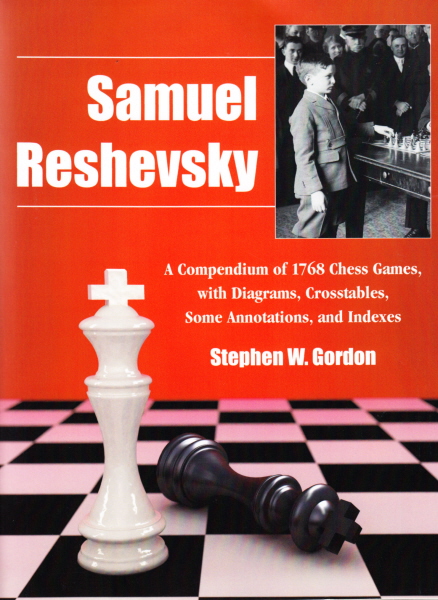
General dealers may cause inflation by copying, or worse, each other’s prices, regardless of considerations of quality or scarcity. Given this indiscriminate greed, with many a wet finger in the wind, no self-respecting author would boast about how much is being charged for his books by such people.
(8225)
As additions to Fischer’s Views on Chess Masters, the following quotes come from the press conference transcripts in No Regrets by Y. Seirawan and G. Stefanović (Seattle, 1992):
Fourth press conference, 21 September 1992 (page 116):
‘Paul Morphy was a great chessplayer, a genius. I’m a little embarrassed when I think that I’ve got a [commemorative] stamp and I’m still even alive. As far as I know he hasn’t got a stamp, at least not in America, and I think it is really outrageous that he hasn’t got a stamp. Nonentities have got a stamp. A few years ago, I think it was a hundredth anniversary of the birth of Capablanca, the Cuban world chess champion, and the Cubans sent me, I think, 30 stamps that they had published and printed about Capablanca just in one year. They already had stamps in earlier years of Capablanca. Morphy, I think everyone agrees, was probably the greatest genius of them all, and he’s never gotten a single stamp. That tells you something about our government.’
Regarding Alekhine, at the sixth press conference, 12 October 1992 (page 173):
‘... a very great player.’
‘Lincoln Lucena’s bid for the FIDE Presidency was strangely low-key and ineffectual. Worse, his “running mate”, Raymond Keene, seemed to pop up almost everywhere in the chess media with statements which, let’s just say, often failed to bear scrutiny.’
Source: Chess Duels by Yasser Seirawan (London, 2010), page 241.
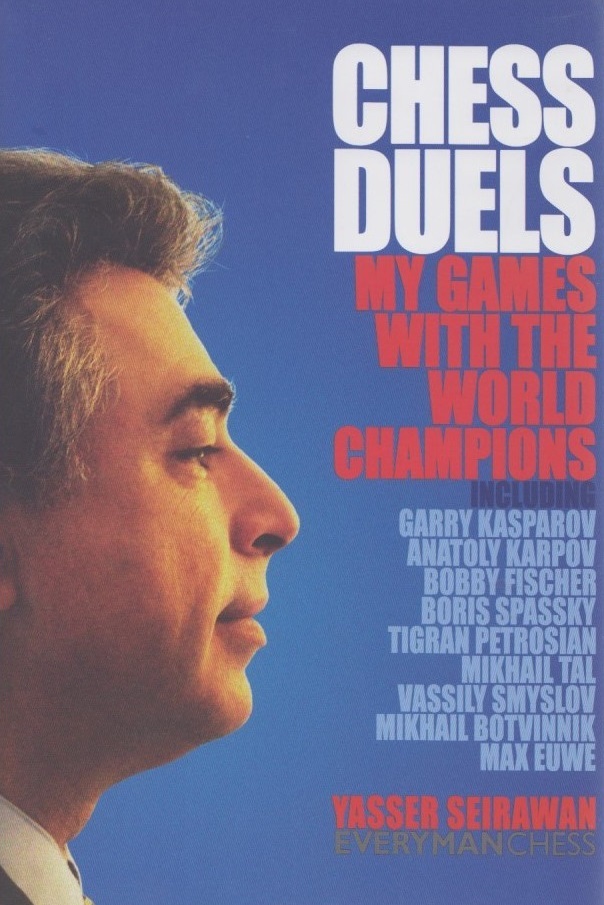
See too The 1986 FIDE Presidential Election and Comic Relief: Raymond Keene and Chess Politics.
A paragraph on page 241 of Chess Duels about Dimitrije Bjelica:
‘We [Kasparov and Seirawan] next met in Bugojno in 1982, the site of one of his most celebrated breakthrough victories. I had accepted an invitation to play. I arrived in Bugojno to find out that I had been “uninvited” and that Miguel Najdorf would take my place. No one bothered to inform me. Ahem. The organizer of the Bugojno tournament, Dimitrije Bjelica, positively put the Linares organizer Luis Rentero on a pedestal of truth, virtue and honesty. It is a travesty that Mr Bjelica is allowed in the chess world at all. For me, he is simply not to be trusted. Let us say I tried as best I could to recover some travel expense money and never returned to the event again.’
From our archives:
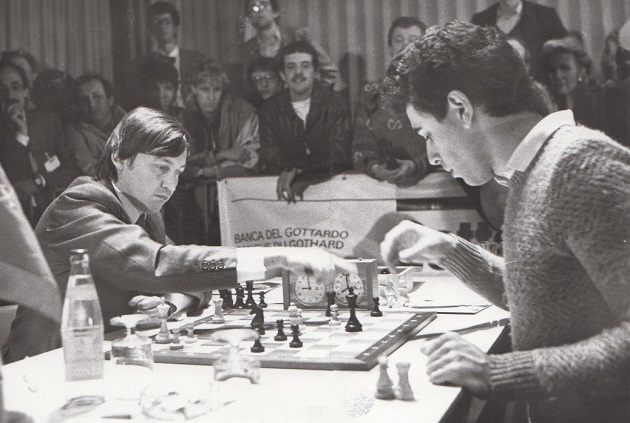
Anatoly Karpov and Yasser Seirawan
(9363)
A photograph taken during the first round of the Sinquefield Cup in St Louis on 23 August 2015 and signed by all ten participants, has kindly been sent to us by Yasser Seirawan:
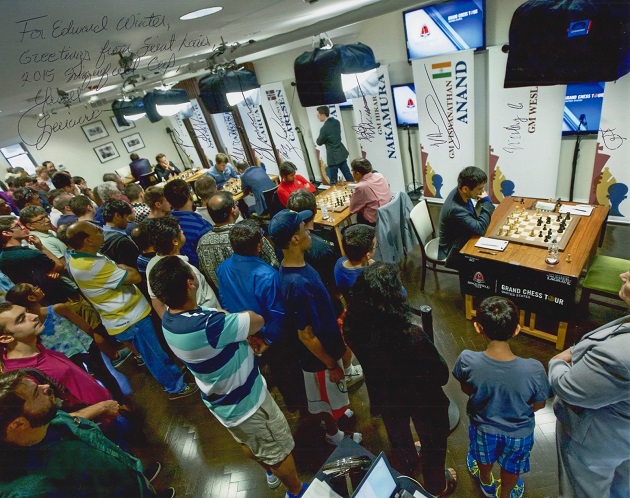
(9510)
The feature article Nimzowitsch’s My System quotes a range of comments on the book, and two recent ones, both negative, are added now, from Chess for Life by Matthew Sadler and Natasha Regan (London, 2016).
On page 143 Nigel Short described My System as ‘a dreadfully boring book’, and on page 164 Yasser Seirawan observed:
‘Personally I found Nimzowitsch unreadable. His ideas on overprotection were over-the-top. He wasn’t the first person to play prophylactically. For some people, though, this book is the cat’s meow. I’ve been told that Nimzowitsch is much better in the original German but some of the humour and nuances have been unavoidably lost in translation.’
Mein System is a rare case of a chess book also existing in a simplified version, edited by Heinz Brunthaler (Zeil am Main, 2007):
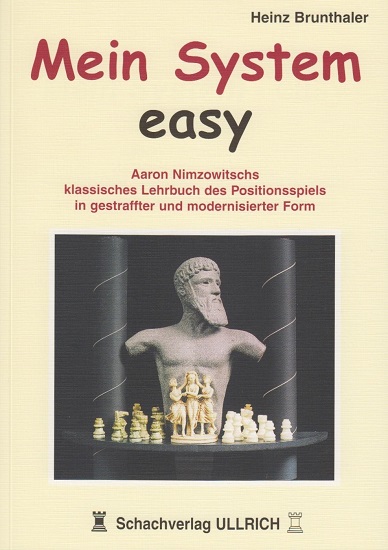
(9792)
Our feature article on the best host commentators on the Internet included Yasser Seirawan:
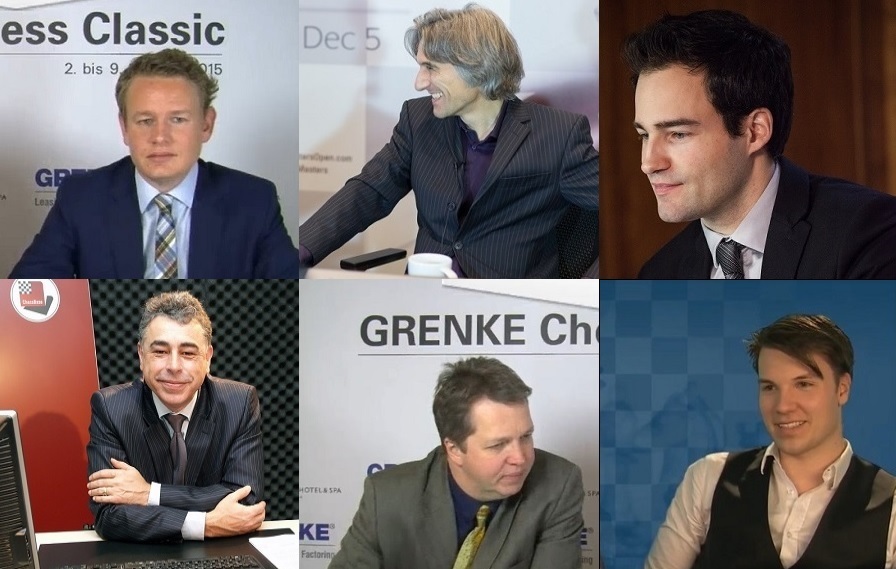
Clockwise from top left: Jan Gustafsson, Daniel King, Yannick Pelletier, Robin van Kampen, Nigel Short and Yasser Seirawan.
Addition on 27 May 2023:
It is now our view that the best Internet chess host of them all is Yasser Seirawan.

Jovanka Houska and Yasser Seirawan, The American Cup, Saint Louis, 17 March 2023 (photograph courtesy of the Saint Louis Chess Club, Austin Fuller)
Addition on 1 December 2023:

A chess commentary dream team (Yasser Seirawan, Jovanka Houska, Peter Svidler), Saint Louis, 22 November 2023 (photograph courtesy of the Saint Louis Chess Club, Lennart Ootes)
On any list of favourite chess players, personalities and writers, Paul Keres is likely to be ranked highly. At about 3:50:00 in a broadcast during round 11 of the US championship in St Louis on 25 April 2016, Yasser Seirawan asked Garry Kasparov about his favourite chess books. The answer included a reference to ‘Keres, 1948’. The book in question, on the 1948 world championship match-tournament, has also been praised recently by Boris Gelfand, in a ChessBase interview conducted by Sagar Shah.
From page 262 of the catalogue Bibliotheca Van der Linde-Niemeijeriana (The Hague, 1955):

As an indication of the quality of Keres’ work, two pages (on his 16th-round win against Euwe in Moscow on 22 April 1948) are given here, from the 331-page Tallinn, 1950 edition:
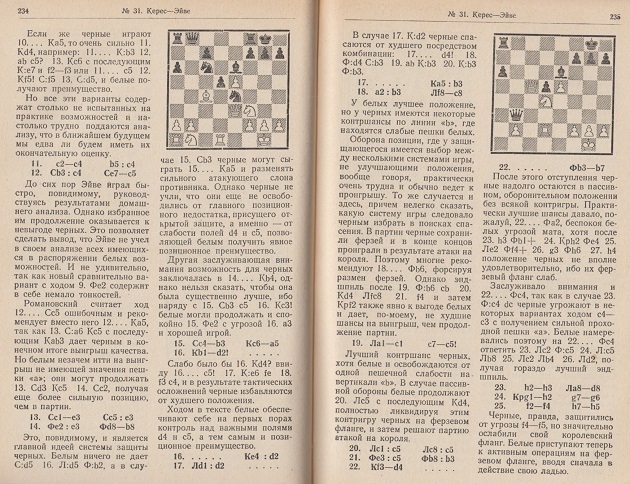
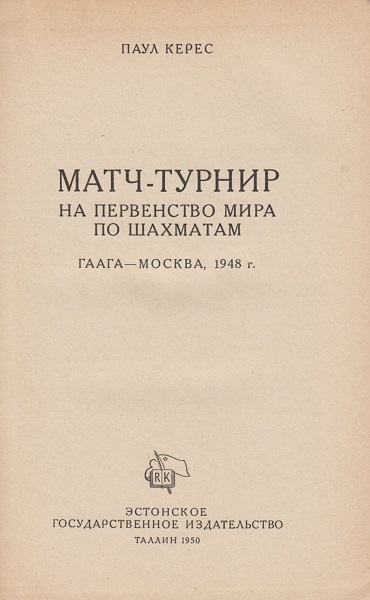
The book is not easily found nowadays, but an augmented edition published in Kharkov in 1999 is still available.
(9893)
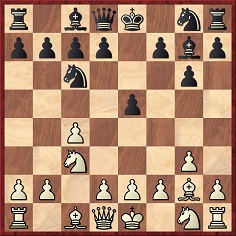
Which move is preferable, 5 d3 or 5 e3?
On pages 67 and 265 of his book on Nottingham, 1936 Alekhine gave contradictory comments about the position after 1 c4 e5 2 Nc3 Nc6 3 g3 g6 4 Bg2 Bg7:
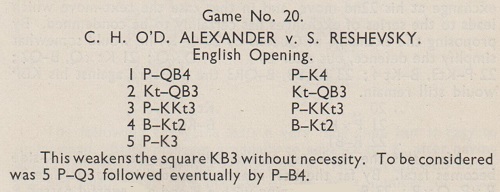
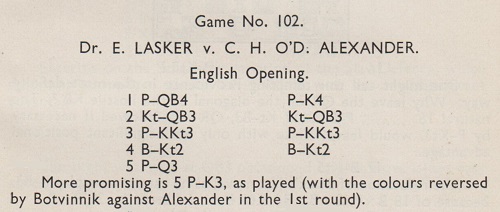
As mentioned in C.N. 2109 (see page 281 of Kings, Commoners and Knaves), the discrepancy was pointed out by T.V. Parrott on page 153 of CHESS, May 1953 and by Arthur Oliver on page 105 of Chess World, June 1962. A later reference is page 15 of Chess Life, January 1963 (in a ‘Chess Kaleidoscope’ article by Eliot Hearst).
(10172)

Position after 4...Bg7
From Yasser Seirawan:
‘Despite Alekhine’s contradictory comments, both the moves that he mentions, 5 d3 and 5 e3, are considered to be main lines of play in modern opening theory.
In his recent works on the English Opening, Mihail Marin has advocated 5 e4, and I wonder whether Alekhine might have suggested that that move weakens f3, d3 and d4. The most surprising comment by Alekhine is that after 5 d3 White may, in time, aspire to play f4; in modern games that simply does not happen.
In view of the forthcoming middlegame, modern masters would judge 5 d3 to be the prelude to a queen’s-side expansion, most often seen with the maneuver Rb1, b4 and b5, chasing away the c6-knight and improving the view of the g2 bishop.
Conversely, 5 e3 is considered rather more flexible. White signals that he intends a central expansion with Nge2, perhaps followed by the advance d4. In that line, White can sometimes also pursue a queen’s-side expansion, as mentioned above, after playing d3. The key difference is that the king’s knight is developed to e2 instead of f3, and in this case White will usually play f4, to counter-act an aggressive king’s-side expansion by Black.
In short, modern theory considers that the two moves given by Alekhine, 5 d3 and 5 e3, are equally good.’
(10176)
The death has just been announced of Luc Winants, aged 60.
A grandmaster with a deep knowledge of chess history, he made many contributions to C.N., with unfailing precision and good humour.
Below we reproduce two photographs (SWIFT tournament, 1986), courtesy of Yasser Seirawan (Hilversum, the Netherlands).
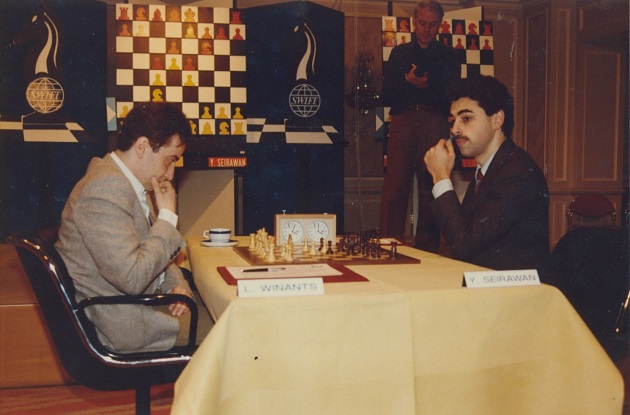
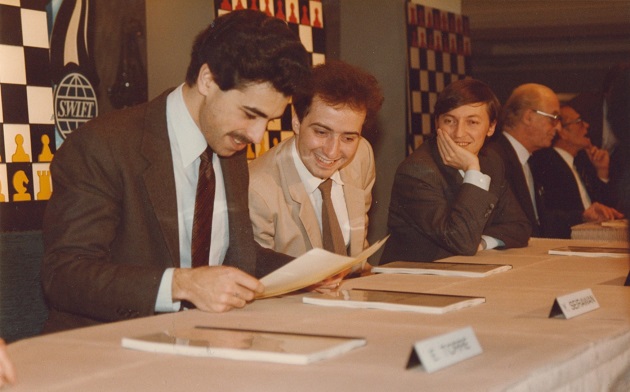
(11936)
Tony Bronzin (Newark, DE, USA) writes regarding Garry Kasparov on Modern Chess Part Four: Kasparov vs Karpov 1988-2009 (London, 2010):
‘I wanted to read Kasparov’s version of the behind-the-scenes happenings of the 1994 Moscow Olympiad, delineated so well in Inside Chess and barely touched upon in Chess Life. Since Kasparov devoted multiple pages to why the 1983 Pasadena match with Korchnoi did not take place and 30 pages to his version of what happened after game 48 of the first match with Karpov, situations where at least a case can be made that he was wronged, surely Kasparov would have at least said something about the 1994 Olympiad and why Karpov was not allowed to field a second Russian team. Not a peep ...’
We are grateful to Yasser Seirawan (St Louis, MO, USA) for permission to show the coverage (nine pages) in the 1/1995 issue of Inside Chess.

(12153)
Addition on 5 June 2025:
Tony Bronzin quotes the following remarks by Yasser Seirawan at the conclusion of an interview with Frank Elley on pages 23 and 53 of the September 1983 Chess Life:
‘My future is very bright. The problem is I seem to be the only one who knows this. I would like everyone to share this little secret.
My goal as a chess professional has never wavered. I shall be the world champion.’
To the Chess Notes main page.
To the Archives for other feature articles.
Copyright: Edward Winter. All rights reserved.